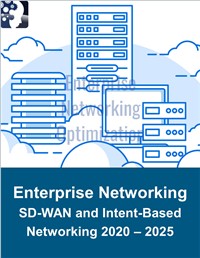This enterprise networking optimization research analyzes the SD-WAN market including an evaluation of the players (vendors and service providers), strategies, technologies, and solutions. It includes analysis by Component, Appliance, Services, Deployment, Segment (Communication Service Providers, Enterprise, Industrial, and Government), and Enterprise Verticals with forecasts from 2020 to 2025.
It also evaluates the intent based networking market including comparison of IBN with traditional networking in terms of architecture, capabilities, and benefits for carrier and enterprise networks. The report analyzes technologies, infrastructure, and the impact of implementing intent-based networking in conjunction with other emerging technologies such as Multi-access Edge Computing (MEC), 5G, AI, and IoT. The report also evaluates leading vendors, strategies, and solutions.
The report also provides market forecasts for 2020 to 2025 globally and regionally as well as by technology and solution. This includes Infrastructure (Hardware, Software, Components, and Services - further broken down by programs, API, and SDK), Solutions/Applications, Deployment Type, Degree of Virtualization (Physical Network, Virtual Network, and Hybrid Network), Network Type (WAN, MAN, LAN, PAN), Connection Type (Wired and Wireless - further broken down by 3G, LTE, and 5G), Artificial Intelligence Type (Deep Machine Learning, Deep Neural Network, Machine Vision System, Predictive Analytics, NLP and Voice Recognition), Organization Type (SMB, Enterprise, Government), and Industry Verticals (Automotive, Financial, Government, Healthcare, Manufacturing/Automation, Telecom and IT, and more).
SDN in support of Wide Area Networking (WAN), also known as SD-WAN, is rapidly achieving mainstream adoption as both network operators and enterprise take a software-centric approach to more optimally manage WAN operations and provide efficient access to cloud applications. Part of the reason for its popularity is the technology enables solutions that provide a more open hardware architecture configuration. This facilitates greater flexibility overall as well as ease of migration from proprietary boxes and multiprotocol label switching services, which is a dominant industry trend as networks increasingly utilize virtualized infrastructure and non-proprietary equipment.
Many consider SD-WAN part of the evolution of SDN as applied to existing networking technologies such as Multiprotocol Label Switching (MPLS), which directs data from one node to the next based on short path labels rather than long network addresses. SD-WAN was often applied as an overlay to existing network technologies such as MPLS virtual private networks and the Internet as a whole. SD-WAN saw early favor with enterprise networks on a managed service basis but has also gained great support with communication service providers (CSP) as a means of unifying networks that are increasingly becoming software-controlled and virtualized.
Intent Based Networks capture business intent, and in so doing, bridge the gap between business operations and information technology. The benefits of intent based networking are many and varied, but arguably all improvements stem from the ability for IBN to automate network management and orchestration in a proactive and intelligent manner. Accordingly, intent based networking represents a solution set that is at the confluence of a few key technologies including machine learning (and other forms of artificial intelligence), Software Defined Networking (SDN), and Internet of Things (IoT) technologies.
One of the key capabilities of intent based networking is the ability to monitor, identify and react in real time to changing network conditions. This pertains to network (and related apps and services) provisioning and administration as well as proactively and autonomously managing change in operational conditions. As a core concept, intent based networking is not completely new, as SDN capabilities have been evolving for many years. However, a much timelier development for intent based networking is the advent of machine learning algorithms capable of providing network automation.
More specifically, intent based networking is defined largely by the extent to which network orchestration is automated, including software that may implement changes autonomously. Networks are increasingly becoming more self-aware and capable of dynamic optimization, often in real-time. In some cases, changes are made to enhance a current state. In other cases, remediation is required to adjust a sub-optimal condition or situation that has gone awry. Analysts see this as an area in which machine learning will become extremely valuable for IBN as AI will provide networks the ability to identify and learn from patterns and behaviors, leading to autonomous decision making, reducing human errors and costs while improving efficiency.
Target Audience:
- AI Companies
- IBN Solution Providers
- IoT Infrastructure Providers
- Security and Analytics Providers
- Communication Service Providers
- Cloud Services and Datacenter Companies
Select Research Findings:
- Global aggregate intent-based network market will exceed $5B by 2025
- Intent based networking will fundamentally transform datacenter operations
- SDX and SD-WAN technologies will be the foundation of intent based networking
- Combination of AI and IoT (AIoT) will add significant value to Intent Based Networking
- Over 70% of enterprise companies will deploy intent based network in some form by 2025



